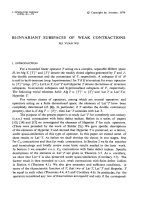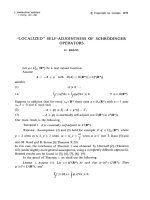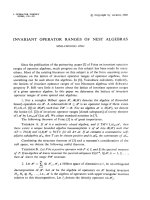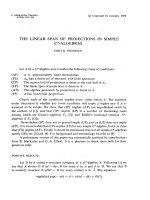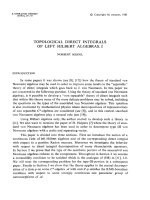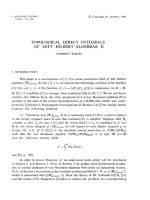Báo cáo toán học: "Uniquely Hamiltonian Characterizations of Distance-Hereditary and Parity Graphs" ppsx
Bạn đang xem bản rút gọn của tài liệu. Xem và tải ngay bản đầy đủ của tài liệu tại đây (83.63 KB, 5 trang )
Uniquely Hamiltonian Characterizations
of Distance-Hereditary and Parity Graphs
Terry A. McKee
Department of Mathematics & Statistics
Wright State University, Dayton, Ohio 45435 USA
Submitted: Apr 9, 2007; Accepted: Sep 19, 2008; Published: Sep 29, 2008
Mathematics Subject Classifications: 05C75, 05C45
Abstract
A graph is shown to be distance-hereditary if and only if no induced subgraph
of order five or more has a unique hamiltonian cycle; this is also equivalent to every
induced subgraph of order five or more having an even number of hamiltonian cycles.
Restricting the induced subgraphs to those of odd order five or more gives two
similar characterizations of parity graphs. The close relationship between distance-
hereditary and parity graphs is unsurprising, but their connection with hamiltonian
cycles of induced subgraphs is unexpected.
1 Distance-hereditary graphs
Howorka [10] defined a graph to be a distance-hereditary graph if the distance between
vertices in connected induced subgraphs always equals the distance between them in the
full graph. This is equivalent to every cycle of length five or more having two crossed
chords; [1, 4, 7, 9] contain many additional characterizations.
Lemma 1 will state two characterizations of distance-hereditary graphs from [1] that
will be used below. As in [4], the vertices in a set S ⊂ V (G) are twins if they all have
exactly the same neighbors in G − S and are either pairwise adjacent (in which case
they are true twins) or pairwise nonadjacent (in which case they are false twins). A
pendant vertex is a vertex v for which there is a vertex w such that N(v) = {w}; the
edge vw is then a pendant edge. A graph G
is a one-vertex expansion [1] of a graph G if
V (G
) = V (G) ∪ {v
} = V (G) where either v
has a twin vertex v in G or v
is a pendant
vertex of G
.
Lemma 1 (Bandelt & Muller 1986) Each of the following is equivalent to G being a
distance-hereditary graph:
the electronic journal of combinatorics 15 (2008), #N36 1
(1.1) Each component of G is built from a single vertex by a sequence of one-vertex ex-
pansions.
(1.2) G contains no induced cycle of length five or more and no induced house, gem, or
domino subgraph (see Figure 1).
t
t
t
❅
❅t
t
t
t
t❉
❉
❉
❉
❉❉
❅
❅
❅
☎
☎
☎
☎
☎☎
t
❅
❅t
t
t
t
t
t
t
Figure 1: From left to right, the house, gem, and domino graphs.
Theorem 2 presents two new characterizations of distance-hereditary graphs. A graph
is uniquely hamiltonian [3] if it has a unique hamiltonian cycle (see [8] for updated dis-
cussion).
Theorem 2 Each of the following is equivalent to being distance-hereditary:
(2.1) No induced subgraph of order five or more is uniquely hamiltonian.
(2.2) Every induced subgraph of order five or more has an even number of hamiltonian
cycles.
Proof. First suppose G is a distance-hereditary graph [toward showing (2.2)]. Using
(1.1) of Lemma 1 and arguing by induction, suppose a connected graph G satisfies (2.2)
and G
is a one-vertex expansion of G with V (G
) = V (G) ∪ {v
} [toward showing that
G
also satisfies (2.2)]. Suppose H is any induced subgraph of G
of order five or more,
noting that if H has no spanning cycle then H has zero hamiltonian cycles. So suppose
H has a spanning cycle C [toward showing that H has an even number of hamiltonian
cycles]. If v
is a pendant vertex of G
, then v
∈ V (C) = V (H), so H is an induced
subgraph of G and so has an even number of hamiltonian cycles. Suppose v
is the twin of
some v ∈ V (G). If v
∈ V (H), then H has an even number of hamiltonian cycles since H
is an induced subgraph of G. If v
∈ V (H) but v ∈ V (H), then H has an even number of
hamiltonian cycles since G
−v
∼
=
G. So suppose H contains both the twins v and v
. Say
that C is ‘equivalent’ to any spanning cycle C
of H for which vx ∈ E(C) ⇔ v
x ∈ E(C
)
for every x ∈ V (H). Doing this over all the spanning cycles of H produces equivalence
classes of cardinality two. Therefore, there must be an even number of such spanning
cycles C, which means that H has an even number of hamiltonian cycles.
Therefore, being a distance-hereditary graph implies condition (2.2). Condition (2.2)
trivially implies (2.1). Condition (2.1) implies being a distance-hereditary graph by con-
traposition, since each of the forbidden subgraphs described in (1.2) is uniquely hamilto-
nian of order five or more. ✷
Theorem 2 essentially says: A graph is a distance-hereditary graph if and only if every
uniquely hamiltonian induced subgraph is isomorphic to C
3
, C
4
, or K
1,1,2
(
∼
=
K
4
with an
edge deleted).
the electronic journal of combinatorics 15 (2008), #N36 2
A block of a graph is a maximal nonseparable subgraph. A graph in which every block
is complete is frequently called a block graph (or sometimes a Husimi tree or a completed
Husimi tree); see [4] for characterizations. Every block graph is distance-hereditary, but
C
4
is a distance-hereditary graph that is not a block graph.
Corollary 3 Every block of a graph is complete if and only if :
(3.1) No induced subgraph of order four or more is uniquely hamiltonian.
Every block of a graph is isomorphic to K
2
or K
3
if and only if :
(3.2) Every induced subgraph of order four or more has an even number of hamiltonian
cycles.
Proof. First suppose every block of G is complete. Then G is a distance-hereditary graph
and so, by (2.1), no induced subgraph of G of order five or more is uniquely hamiltonian.
The only order-4 graphs that are uniquely hamiltonian (C
4
and K
1,1,2
) fail to have every
block complete. Therefore, no induced subgraph of G of order four or more is uniquely
hamiltonian.
Conversely, if G has a block that is not complete, then G either contains an induced
cycle C
k
with k ≥ 4 or an induced K
1,1,2
. In either case, G contains an induced subgraph
of order four or more that is uniquely hamiltonian.
The second part of the corollary is proved similarly, noting the following:
(1) The only order-4 graphs with an odd number of hamiltonian cycles (C
4
, K
1,1,2
, and
K
4
) fail to have every block isomorphic to K
2
or K
3
.
(2) A graph with a block that is not isomorphic to K
2
or K
3
has an induced cycle C
k
with k ≥ 4 or an induced K
1,1,2
or K
4
, and so has an induced subgraph of order
four or more that has an odd number of hamiltonian cycles. ✷
By comparison, graph is a forest if and only if no induced subgraph of order three
or more is uniquely hamiltonian, which is also equivalent to every induced subgraph of
order three or more having an even number (zero) of hamiltonian cycles. In other words,
a graph is a forest if and only if no induced subgraph is uniquely hamiltonian.
2 Parity graphs
Burlet & Uhry [5] defines a graph to be a parity graph if, for every pair of vertices, the
lengths of all the induced paths between them have the same parity. This is equivalent
to every cycle of odd length five or more having two crossed chords; [2, 4, 6] contain
additional characterizations. Every distance-hereditary graph is a parity graph, but the
domino graph (see Figure 1) is a parity graph that is not a distance-hereditary graph.
Lemma 4 will state two characterizations of parity graphs from [5] that will be used
below. Suppose G is any graph with false (independent) twins x
1
, . . . , x
n
(n ≥ 1) and
B is any bipartite graph vertex disjoint from G that contains vertices y
1
, . . ., y
n
from a
common color class. As in [5], a vertex extension G
of G by a bipartite graph B, with
respect to the extension vertices x
1
, . . . , x
n
results from identifying the vertices x
i
and y
i
the electronic journal of combinatorics 15 (2008), #N36 3
for each i ≤ n. (The vertex extension by B
∼
=
K
2
with respect to n = 1 extension vertex
is the one-vertex expansion that has B a pendant edge.) A short chord of a cycle C is an
edge uw where u and w are a distance two apart along C.
Lemma 4 (Burlet & Uhry 1984) Each of the following is equivalent to G being a par-
ity graph:
(4.1) Each component of G is built from a single vertex by a sequence of one vertex
expansions and vertex extensions by bipartite graphs.
(4.2) G contains no induced cycle of odd length five or more, possibly with a unique short
chord, and no induced gem subgraph (see Figure 1).
Theorem 5 Each of the following is equivalent to being a parity graph:
(5.1) No induced subgraph of odd order five or more is uniquely hamiltonian.
(5.2) Every induced subgraph of odd order five or more has an even number of hamiltonian
cycles.
Proof. First suppose G is a parity graph [toward showing (5.2)]. Using (4.1) of Lemma 4
and arguing by induction, suppose a connected graph G satisfies (5.2) and G
is either a
one vertex expansion of G or a vertex extension of G by a bipartite graph [toward showing
that G
also satisfies (5.2)]. Suppose H is any induced subgraph of G
of odd order five
or more, noting that if H has no spanning cycle then H has zero hamiltonian cycles.
So suppose H has a spanning cycle C [toward showing that H has an even number of
hamiltonian cycles]. If V (C) ⊆ V (G), then H is an induced subgraph of G and so has
an even number of hamiltonian cycles. So suppose V (C) ⊆ V (G). If G
is a one vertex
expansion of G, then argue precisely as in the proof of Theorem 2.
Suppose G
is a vertex extension by a bipartite graph B with respect to extension
vertices x
1
, . . . , x
n
. Reorder the subscripts if necessary so that x
1
, . . . , x
k
are those vertices
at which C passes between G and B. (It is possible to have k < n because an extension
vertex could have both its edges along C in G or both in B.) For each 1 ≤ i ≤ k, let w
i
be the neighbor of x
i
∈ V (G) − V (B) along C. Say that C is ‘equivalent’ to any spanning
cycle C
of H that uses the same sets {x
1
, . . . , x
k
} and {w
1
, . . . , w
k
}. Since x
1
, . . . , x
n
are
false twins in G, if edges x
i
w
i
and x
i+1
w
i+1
are in a common path along C within G,
then those two edges can be replaced with x
i
w
i+1
and x
i+1
w
i
to form a distinct equivalent
cycle C
. Doing this over all the spanning cycles of H produces equivalence classes of even
cardinality. Therefore, there must be an even number of such spanning cycles C, which
means that H has an even number of hamiltonian cycles.
Therefore, being a parity graph implies condition (5.2). Condition (5.2) trivially im-
plies (5.1). Condition (5.1) implies being a parity graph by contraposition, since each of
the forbidden subgraphs described in (4.2) is uniquely hamiltonian of odd order five or
more. ✷
Theorem 5 essentially says: A graph is a parity graph if and only if its only uniquely
hamiltonian induced subgraphs are triangles.
the electronic journal of combinatorics 15 (2008), #N36 4
By comparison, notice that a graph is bipartite if and only if no induced subgraph
of odd order is uniquely hamiltonian, which is also equivalent to every induced subgraph
of odd order having an even number (zero) of hamiltonian cycles. (This follows from
Theorem 5, using that C
3
is the only order-3 hamiltonian graph and that every non-
bipartite graph contains an induced cycle C
k
with k odd.)
References
[1] H J. Bandelt and H. M. Mulder. Distance-hereditary graphs. J. Combin. Theory
(Ser. B) 41 (1986) 182–208.
[2] H J. Bandelt and H. M. Mulder. Metric characterization of parity graphs. Discrete
Math. 91 (1991) 221–230.
[3] C. A. Barefoot and R. C. Entringer, Extremal maximal uniquely Hamiltonian graphs,
J. Graph Theory 4 (1980) 93–100.
[4] A. Brandst¨adt, V. B. Le, and J. P. Spinrad, Graph Classes: A Survey, Society for
Industrial and Applied Mathematics, Philadelphia, 1999.
[5] M. Burlet and J P. Uhry, Parity graphs, in Topics on Perfect Graphs [C. Berge
and V. Chv´atal, eds., North-Holland, Amsterdam] Ann. Discrete Math. 21 (1984)
253–277.
[6] S. Cicerone and G. Di Stefano, On the extension of bipartite to parity graphs, Discrete
Appl. Math. 95 (1999) 181–195.
[7] A. D’Atri and M. Moscarini. Distance-hereditary graphs, Steiner trees, and connected
domination. SIAM J. Comput. 17 (1988) 521–538.
[8] R. J. Gould, Advances on the Hamiltonian problem—a survey, Graphs Combin. 19
(2003) 7–52.
[9] P. L. Hammer and F. Maffray. Completely separable graphs. Discrete Appl. Math.
27 (1990) 88–99.
[10] E. Howorka. A characterization of distance-hereditary graphs. Quart. J. Math. Oxford
(Ser. 2) 28 (1977) 417–420.
the electronic journal of combinatorics 15 (2008), #N36 5
